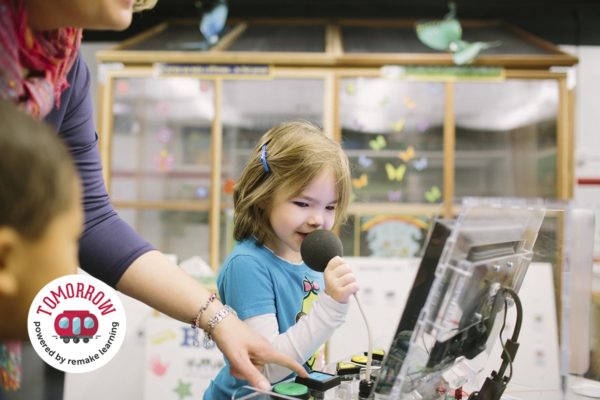
What should the future of learning look like? Ask the students.
By Melissa Rayworth
What can we do today to make tomorrow a more promising place for all learners?
The Tomorrow campaign began asking this question in May of this year. Through five months of remote learning, socially distanced summer break and a back-to-school season like no other, “we’ve had literally hundreds of conversations about the future of teaching and learning,” says Ani Martinez, field director for Remake Learning.
Martinez and the Tomorrow team have talked with a wide range of people who think wisely and deeply about this question: teachers, school administrators, education policymakers, out-of-school-time providers and learning innovators, along with parents and caregivers who are now playing a central role in children’s educational lives.
But alongside these caring adults, the campaign has made sure to center the voices of one group above all: young people.
In live events, podcast projects and reported stories, we’ve asked them: What do they need in order to flourish in a future of unknown possibilities? How can we best prepare them for the future while staying grounded in what — for very good reasons — is timeless?
We’ve asked students to tell us about the things that are working and to be blunt with us about what’s still needed. Here’s what they’ve said:
Prepare us to function in the world today so we can begin to shape the world of tomorrow.
Tyree Allie, a student and mentor at Homewood-Brushton YMCA’s Lighthouse Project in Pittsburgh, remembers spending long days in high school doing lessons he found repetitive.
Teachers sometimes mentioned critical thinking. But only rarely, if ever, did they let students use critical thinking to solve real problems. “I’m 21,” he says. “But I don’t know how to survive in the society that taught me about my society. So where do I go from here?”
Young people tell us they are hungry for hands-on, practical knowledge about the real world. They want to understand how communities work and what they can do to improve them.
And they can have that — if communities build learning ecosystems like the one that’s been growing for a decade in Pittsburgh through the Remake Learning network.
Make what we learn — and how we learn — truly equitable.
Grace Hogan, a sophomore at Peters Township High School and a member of GirlGov, sees the efforts some schools make to teach pieces of the Black experience. But, she says, a powerful Euro-centrism still shapes education in America.
“When we look at racial justice, we always just learn about slavery,” Hogan says. “We don’t learn about Black joy. We don’t learn about anything else other than that.”
Schools can change this, she says, by reassessing the books and materials they use and by deeply examining the ways systemic racism may be built into their systems.
People created these systems, students point out. So people can change them, too.
Make mental health a priority, and let us know you’re there for us.
Over and over, young people have told us they need support with the emotional challenges they’re facing. They need skills to manage their feelings and they need people checking in to ask how they’re doing.
“In order to change the world — in order to do stuff for other people — you need to think about yourself and your mental health first,” Hogan says.
Allie got support only after his personal problems had begun preventing him from going to school. “What about the person who doesn’t know how to reach out for help?” he asks. “What about the shy kid who’s not good at talking to people?”
The key to all this? Caring adults who do ask how kids are doing. And curriculum that includes social-emotional skills.
Dr. Janeen Peretin, director of communication, innovation and advancement at Baldwin-Whitehall SD, recently surveyed teens in the Pittsburgh area to ask how parents or caregivers could better support them.
No matter the age of the child, they all had the same message for adults: “they simply want to know that you’re in their corner and you love them,” Peretin told the audience at a Transform for Tomorrow webinar in September.
That’s exactly it, says Maisie Johnston, a freshman at Shadyside Academy and member of TeenBloc.
Right now, the world “looks really bleak to a lot of people,” she says. “The thing they really need is just love and support and someone telling them, ‘It will be OK. And even if it’s not, other people around you understand. And they can help.’”
It’s true. We can help.
And though the first phase of the Tomorrow campaign is now ending, there is much more to come: more live events, more projects and more grant opportunities to give young people the kinds of learning that will prepare them for whatever tomorrow might bring.
Learning innovation is happening right now, and the demand for it has only grown in recent months. People are listening and are open to new ideas. If we build on those ideas, remarkable change can happen.
The future will be built by today’s youth, Tyree Allie said during the final Tomorrow livestream event this month.
But before young people can build a better world, he said, “we need to fix the way that we’re teaching them first.”
This article is part of a series for “Tomorrow” powered by Remake Learning. From May to October, “Tomorrow” will explore – through virtual events, grantmaking, and storytelling – what we can do today to make tomorrow a more promising place for all learners. Follow along or share your hopes for today’s young people using the hashtag #RemakeTomorrow and tagging @RemakeLearning. Learn more about Remake Learning here. And read more “Tomorrow” articles published on Kidsburgh.